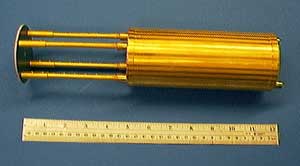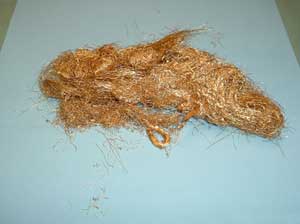Satellite leftovers to fuel weather, climate research
A spool of 1,600 gold threads, each thinner than one uncooked spaghetti noodle, formed the insides of the beer can-sized component in a space-bound refrigerator. The University of Wisconsin-Madison center responsible for this unit recently sold the leftover gold to fund remote-sensing research.
UW-Madison’s Space Science and Engineering Center (SSEC) sold the gold for $8,001 in a UW online auction that ended on Feb. 5. Meant to fly into outer space, the gold will instead contribute to research that enhances the understanding of not only the Earth’s atmosphere but those of other planets as well.
The golden refrigerator piece is one project in a long history of spaceflight hardware development at SSEC — innovative work in remote-sensing technology that continues to advance weather and climate research. Work on future satellite instruments and concepts as well as outreach programs to help the public understand atmospheric research and technology will likely benefit from the auction of the gold.

Filled with a carefully grown salt crystal, the cylinder becomes a salt pill. Inside the refrigerator, a magnetic field activates the salt pill so that it absorbs heat and keeps the satellite’s X-ray detectors freezing cold.
Filled with a carefully grown salt crystal, the cylinder becomes a salt pill. Inside the refrigerator, a magnetic field activates the salt pill so that it absorbs heat and keeps the satellite’s X-ray detectors freezing cold.
Initially, SSEC purchased the spool of gold for an instrument slated for flight aboard a satellite built by NASA and the Japanese Space Agency. SSEC engineers were asked to build a subsystem of a refrigerator capable of cooling the satellite’s X-ray detectors to less than the temperature of space. The detectors needed to keep cold enough to sense the heat generated by one X-ray photon. One component of the subsystem consisted of 1,600 gold threads individually stretched to, without touching, form a 7-inch cylinder with a diameter close to that of a beer can.
After devising a way to keep the threads separate, the engineers carefully grew a relatively giant salt crystal that occupied the entire can. “It’s kind of like a recipe,” says SSEC engineer Mark Mulligan. “Two people can follow the directions to the letter, but one just tastes better.”
Tony Wendricks, an engineer on the SSEC team responsible for carefully growing the crystal, described the crystal’s structure as “a pile of stones with no spaces in between.”
With the completed crystal, the cylinder becomes a salt pill. Inside the refrigerator, a magnetic field activates the salt pill so that it absorbs heat and keeps the X-ray detectors freezing cold. The threads act as thermal conductors that direct the heat into the crystal. The team chose gold because it could survive in the destructive solution used to grow the salt crystal.
After overcoming everything from peeling apart accidentally melted threads to figuring out how to seal the salt pill, SSEC engineers exceeded NASA’s expectations for the completed high-tech fridge. Unfortunately, the satellite ended up at the bottom of the Pacific Ocean. SSEC made several spares, so the technology had a second chance in 2005 when Japan launched a second version of the satellite. NASA might also use the technology in an airborne observatory that will study the atmosphere in the infrared spectrum.
— Jen O’Leary
Released through University Communications on 06 Feb 2007

